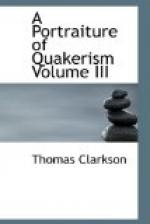Now these conclusions, the Quakers say, seem to have been sanctioned, in a great measure, by the primitive practice for the three first centuries of the church, or till the darkness of apostacy began to overwhelm the religious world.
In the very early times of the Gospel, many Christians, both at Jerusalem and Alexandria in Egypt, sold their possessions, and lived together on the produce of their common stock. Others in Antioch, Galatia, and Pontus, retained their estates in their possession, but established a fund, consisting of weekly or monthly offerings, for the support of the church. This fund continued in after times. But it was principally for the relief of poor and distressed saints, in which the ministers of the Gospel, if in that situation, might also share. Tertullian, in speaking of such funds, gives the following account: “Whatsoever we have, says he, in the treasury of our churches, is not raised by taxation, as though we put men to ransom their religion, but every man once a month, or when it pleaseth him, bestoweth what he thinks proper, but not except he be willing. For no man is compelled, but left free to his own discretion. And that, which is thus given, is not bestowed in vanity, but in relieving the poor, and upon children destitute of parents, and in the maintenance of aged and feeble persons, and of men wrecked by sea, and of such as have been condemned to metallic mines, or have been banished to islands, or have been cast into prison, professing the Christian faith.”
In process of time, towards the close of the third century, some lands began to be given to the church. The revenue from these was thrown into the general treasury or fund, and was distributed, as other offerings were, by the deacons and elders, but neither bishops nor ministers of the Gospel were allowed to have any concern with it. It appears from Origen, Cyprian, Urban, Prosper, and others, that if in those times such ministers were able to support themselves, they were to have nothing from this fund. The fund was not for the benefit of any particular person. But if such ministers stood in need of sustenance, they might receive from it; but they were to be satisfied with simple diet, and necessary apparel. And so sacred was this fund held to the purposes of its institution, that the first Christian emperors, who did as the bishops advised them, had no recourse to it, but supplied the wants of ministers of the Gospel from their own revenues, as Eusebius, Theodoret, and Sozomen relate.
The council of Antioch, in the year 340, finding fault with the deacons relative to the management of the funds of the churches, ordained that the bishops might distribute them, but that they should take no part of them to themselves, or for the use of the priests and brethren who lived with them, unless necessity required it, using the words of the Apostle, “Having food and raiment, be therewith content.”




